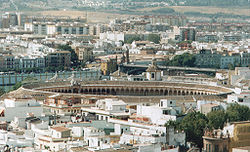
Plaza de toros de la Real Maestranza de Caballería de Sevilla
Encyclopedia


Real Maestranza de Caballería de Sevilla
The Real Maestranza de Caballería de Sevilla is a noble guild created in 1670 from the remnants of the preceding Cofradía de San Hermenegildo...
is the oldest bullring
Bullring
A bullring is an arena where bullfighting is performed. Bullrings are often associated with Spain, but they can also be found in neighboring countries and the New World...
in Spain
Spain
Spain , officially the Kingdom of Spain languages]] under the European Charter for Regional or Minority Languages. In each of these, Spain's official name is as follows:;;;;;;), is a country and member state of the European Union located in southwestern Europe on the Iberian Peninsula...
. It is the site of the annual Feria de Abril in Seville
Seville
Seville is the artistic, historic, cultural, and financial capital of southern Spain. It is the capital of the autonomous community of Andalusia and of the province of Seville. It is situated on the plain of the River Guadalquivir, with an average elevation of above sea level...
, one of the most well-known bullfighting
Bullfighting
Bullfighting is a traditional spectacle of Spain, Portugal, southern France and some Latin American countries , in which one or more bulls are baited in a bullring for sport and entertainment...
festivals in the world.
The ring itself is considered one of the city's most enjoyable tourist attractions and is certainly one of the most visited. As a stage for bullfighting, it is considered one of the world's most challenging environments because of its history, characteristics, and viewing public, which is considered one of the most unforgiving in all of bullfighting fandom.
History
Construction began in 1749 of a circular ring on Baratillo hill to take the place of the rectangular bullring that was previously located there. Later, in 1761, the construction began to incorporate ochavas (each ochava being equivalent to four arches). At this early stage, the construction supervisors were Francisco Sánchez de Aragón and Pedro y Vicente de San Martín. The inner facade of the plaza (called the Palco del Príncipe or Prince's Box) was completed in 1765, and this 'box' consists of two parts: the access gate through which the successful bullfighters exit, and the theater box itself, which is reserved for the exclusive use of the Spanish Royal FamilySpanish monarchy
The Monarchy of Spain, constitutionally referred to as The Crown and commonly referred to as the Spanish monarchy or Hispanic Monarchy, is a constitutional institution and an historic office of Spain...
. The topmost part is composed of four arches over which is built a half-orange vault, whose topmost portion is covered by white and blue tiles. The sculptural group that concludes the composition is the work of the Portuguese
Portuguese people
The Portuguese are a nation and ethnic group native to the country of Portugal, in the west of the Iberian peninsula of south-west Europe. Their language is Portuguese, and Roman Catholicism is the predominant religion....
sculptor Cayetano de Acosta. The Palco was built for the Infante de España, Felipe de Borbón, son of Felipe V and Isabel de Farnesio.
When Carlos III
Charles III of Spain
Charles III was the King of Spain and the Spanish Indies from 1759 to 1788. He was the eldest son of Philip V of Spain and his second wife, the Princess Elisabeth Farnese...
prohibited bullfighting celebrations in 1786, work on the sculptures was halted, even though only one-third of the plaza had been completed at the time. The old Palco de la Diputación (earlier called the Palco de Ganaderos or Herdsmen's Box) is also from this period and is situated over the toriles gate and in front of the Palco del Príncipe.
After 34 years the cover of the launching slips of half of the ring was finished, to the left and right of the Palco del Príncipe; being easily viewed from the cathedral and the Giralda it was reflected in a great number of stamps of the time. By 1868 the Palco de la Diputación was in such a lamentable state that Italian sculptor Augusto Franchy undertook the improvement himself, building a new area with a marble balustrade and the crest of the Real Maestranza de Caballería. The construction of five balconies to each side of the Palco de la Diputación was also added where the ring's clock is currently situated.
The construction of the ring was completed in 1881; two thirds were constructed in stone, the rest in wood.
Between 1914 and 1915 the stone grandstands were redone in brick under the direction of Sevillian architect Aníbal González
Aníbal González
Aníbal Segundo González Espinoza is a retired Chilean footballer who played as a forward during his career...
. All the rows were reconstructed with a smoother slope. Ten to twelve rows of shaded seating were constructed as well as fourteen rows in the sun and three rows of barrier. A row of armchairs were built in the superior part of the shaded area, in front of the theater boxes.

